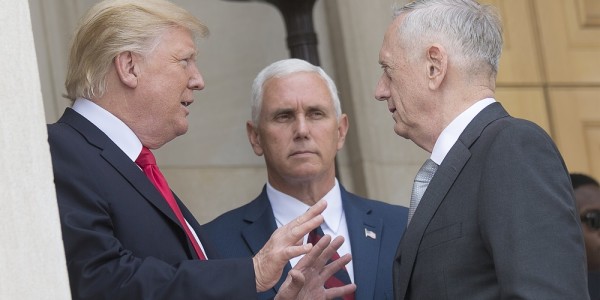

Only four days into the work week, the United States government has already managed to aggravate China, North Korea, and Iran, thus creating the potential for the biggest great-power melee since Bob Barker kicked Adam Sandler’s ass in Happy Gilmore.
Let’s recap:
North Korea on the outs
On Thursday, President Donald Trump cancelled a much-ballyhooed June summit with North Korean dictator Kim Jong Un, while assuring the country that the U.S. military “is ready if necessary.”
Pyongyang been cooling on the idea of both leaders meeting since May 15, when North Korean officials reportedly threatened to cancel the summit over ongoing U.S. and South Korean military exercises. But the final straw came when North Korea’s vice-foreign minister Choe Son Hui lambasted Vice President Mike Pence for “ignorant and stupid remarks” in which Pence suggested that Kim that he could end up like deposed and murdered Libyan dictator Moammar Gadhafi if he held onto his nuclear weapons.
“Sadly, based on the tremendous anger and open hostility displayed in your most recent statement, I feel it is inappropriate, at this time, to have this long-planned meeting,” Trump wrote in a letter to Kim.
China looms large
Trump’s decision to cancel his planned summit with Kim came only a day after the U.S. military disinvited China from participating in this year’s RIMPAC exercises for deploying anti-ship and surface-to-air missiles as well as bombers to their man-made islands in the contested South China Sea.
RIMPAC is slated to begin in June, so telling China so close to the start of the exercise that they are no longer welcome will be interpreted as a “direct slap at the Chinese,” said Dean Cheng, a China expert with the Heritage Foundation think tank in Washington, D.C.
Cheng also noted that Chinese President Xi Jinping in 2015 that China would not militarize the South China Sea, so this marks the first time the United States has called the Chinese on not keeping their word.
The Chinese could retaliate by ramping up its response to U.S. freedom of navigation operations in the South China Sea, he said.
“They could do attack profiles against U.S. ships in the area – start playing chicken of the sea,” Cheng said. “They could go back to harassing U.S. ships as they did with the USNS Impeccable, the USS John S. McCain, and the USS Cowpens. Any of those are possible. They could interfere with aircraft.”
The Persian Menace
With all of this turmoil, it’s hard to remember that on May 21 Secretary of State Mike Pompeo laid out the new U.S. strategy towards Iran, threatening to “crush” Iranian operatives and proxies around the world.
“We will ensure freedom of navigation on the waters in the region. We will work to prevent and counteract any Iranian malign cyber activity,” Pompeo said during a speech at the Heritage Foundation. “We will track down Iranian operatives and their Hezbollah proxies operating around the world and we will crush them. Iran will never again have carte blanche to dominate the Middle East.”
Defense officials have stressed that the U.S. military is part of a wider U.S. government approach to deter Iranian aggression.
“DoD routinely reviews and updates its plans and activities to deal with a host of threats, including those posed by Iran, to deter and, if necessary, respond to aggression,” Pentagon spokeswoman Lt. Cmdr.Rebecca Rebarich said in an email.
On Thursday, McKenzie said the U.S. military has the ability to protect shipping in the Strait of Hormuz in the Persian Gulf and the Bab al Mandab, which connects the Red Sea and Gulf of Aden.
When asked how long it would take for the U.S. military to sink the Iranian fleet, McKenzie replied: “I don’t think that’s useful speculation.”
Just a reminder: The week ain’t over yet.
WATCH NEXT:
